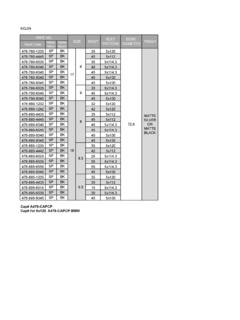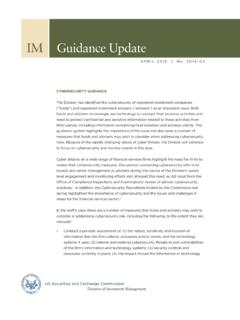Transcription of JapanTrak 2015 - EHIMA
1 Results JapanTrak 2015 overview of hearing aid owners of hearing impaired non-owners Research to create value JHIMAEHIMAEHIMAEHIMAL ocal HM AssociationHSMANIFALFHS ummary 1. Introduction JapanTrak 2015 was designed and executed by Anovum (Zurich) on behalf of Japan Hearing Instruments Manufacturers Association (JHIMA). Sample sizes Japan 2015 : Representative sample (sample 1): n= 14 316 people Hearing impaired (sample 2): n=1 306 people Hearing impaired non-owners: n= 890 people with hearing loss (HL) HA owners: n= 416 people with hearing aid (HA) JapanTrak 2015 is equivalent to the EuroTrak studies: Anovum 2015 - JapanTrak 2015 Page 2 Summary 2. Market overview Stated hearing loss prevalence Total: %, 18+: (2012: , 18+: ). Binaural hearing loss: HA owners: 83%, HA non-owners: 60%. Hearing Tests: 51% (2012: 49%) had a hearing test in the last 5 years, most tests done by ENTs and family doctors. Hearing aid adoption rate (HA penetration) Total: (2012: ).
2 Total age group 18+: (2012: ). 46% of HA owners have binaural treatment. The route to the hearing aid 40% of the hearing impaired discussed hearing loss with an ENT doctor or family doctor. 13% got hearing aids recommended from the ENT or family doctor (drop out rate=68% / 2012: 67%). 17% of the GP consultations referred to a hearing aid dispenser, 18% referred to an ENT 51% recommended no action! 16% of ENT consultations referred to an audiologist, 70% recommended no action! Potential social cost-savings due to the use of hearing aids Hearing aids are believed to have a positive impact on the job. Quality of sleep seems to improve if hearing impaired use hearing aids. Anovum 2015 - JapanTrak 2015 Page 3 Summary 3. Analysis of hearing aid owners Hearing aid ownership and usage and accessories 15% (2012: 12%) of all HA owners received some kind of 3rd party reimbursement. 42% of the currently owned HAs were bought in the last two years The average age of the currently owned HAs is years (2012: years).
3 The median age of hearing aids before replacement is 5 years (2012: 4 years). On average, HAs are worn hours a day (2012: ). 48% of today s hearing aid owners are aware of their hearing aid brand, 48% would preferably choose the same brand if they would plan to obtain new hearing aids (41% are indifferent). TV Box is the most often owned electronic accessory: 11% of hearing aid owners have one 33% have heard of it but don t own one. Importance of listening situations and satisfaction with HAs 60% of the hearing aid owners say their hearing aid works better than or as expected, 40% say they are worse than expected. Overall satisfaction with HA is 39% (2012: 36%). The more hours worn per day, the higher the satisfaction. Talking on a phone and talking at home with family members are the most frequent important listening situations. Positive impact of HAs Significant positive impact of HAs on different aspects especially sense of safety, communication and feelings about yourself.
4 84% of hearing aid owners declare that their hearing aids improve their quality of life at least sometimes Anovum 2015 - JapanTrak 2015 Page 4 Summary 4. Analysis of hearing impaired non-owners Reasons not to own/use HAs Only 9% of the hearing impaired without hearing aids know the system of supplying hearing aid(s) by the government (2012: 6%). The main reasons for not using hearing aids are that people say they are uncomfortable, they do not restore hearing to normal and their hearing loss is not severe enough. Uncomfortable means to them: not necessary yet in daily life , foreign object in the ear , it pinches , it hurts , it is too big . 7% who own HAs don t use them at all (0 hour); 23% use them less than one hour/day (0-1 hour). Social rejection, buying intentions and triggers to buy 68% of hearing aid owners think people don t make fun of or reject them because of their hearing aids. It is more likely somebody makes fun or rejects a hearing impaired without hearing aids.
5 The most important influencing factors for getting hearing aids are worsening hearing loss, ENT, spouse/child and hearing aid center. Price of hearing aids is only relevant for the non owners. 6% (2012: 4%) of non-owners intend to get a hearing aid within the next year. Hearing aid centers, doctors and optical shops are the most important sources of information and therefore the major gatekeepers followed by the internet. Anovum 2015 - JapanTrak 2015 Page 5 Results JapanTrak 2015 overview of hearing aid owners of hearing impaired non-owners Creative Market Research Detailed Results: Roadmap New topics for JapanTrak 2015 are highlighted in red Organisation of JapanTrak 2015 Recruitment process: In search of hearing impaired people overview Prevalence of hearing loss and hearing aid adoption rate Hearing tests and where hearing is tested The route to the hearing aid: Sources of information and drop-out rates Potential social cost-savings due to the use of hearing aids.
6 Work competitiveness, depressive and dementia symptoms, sleep quality of hearing aid owners Hearing aid ownership, awareness of hearing loss before getting hearing aids, lifetime of hearing aids and usage Awareness and usage of accessories Satisfaction with hearing aids and drivers Importance of listening situations Positive impact of hearing aids, quality of life of hearing impaired non-owners Reasons for not having hearing aids and why some people can consider hearing aids as uncomfortable Social rejection because of hearing loss compared to the acceptance of hearing aids Buying intentions and most important triggers to buy Demographics: Hearing instrument adoption rates and populations Anovum 2015 - JapanTrak 2015 Page 7 1. Introduction Anovum 2015 - JapanTrak 2015 Page 8 Organisation of JapanTrak 2015 Organisation JapanTrak is the Japanese equivalent to the EuroTrak studies. Principal of the project JapanTrak is Japan Hearing Instruments Manufacturers Association (JHIMA).
7 Members of JHIMA are: bernafon, CORTITON, GNresound, NJH (New Japan Hearing), Oticon, PANASONIC, Phonak, RION, Sivantos (Siemens), Starkey, Widex [JHIMA Companies]. Anovum Zurich developed the concept of JapanTrak , designed the questionnaire and conducted the fieldwork in cooperation with a panel company. Furthermore Anovum analysed the data and prepared the presentation. The European Hearing Instrument Manufacturers Association [ EHIMA ] approved the questionnaire. Anovum and JHIMA adapted the EuroTrak questionnaire for JapanTrak . JHIMA translated the questionnaire into Japanese. Use of the data The principal as well as the JHIMA companies may use the anonymous delivered tables, charts, reports and conclusions of the survey for further research projects, for archiving and publication in any form whatsoever. The raw dataset remains at Anovum. If the principal or the JHIMA companies use the anonymous data (delivered tables, charts, reports) and conclusions of the survey for publications the source of the data needs to be mentioned in the following way: Source: Anovum JapanTrak 2015 /n=[relevant sample size] The principal and JHIMA companies can ask Anovum to further analyse the raw data in specific ways at their own expense.
8 Anovum 2015 - JapanTrak 2015 Page 9 Recruitment process: In search of hearing impaired people Step 1: Screening interviews Objective: Prevalence of hearing loss and hearing aid ownership Process: sample with strict quotas that represent the overall population (Age/Gender interlocked; soft quota on region) from panelist pools of more than 40 000 people questionnaire: Stated hearing loss and hearing aid usage + demographics : Representative sample of n= 14 316 people based on census data. Step 2: Target population interviews Objective: Details about satisfaction with hearing aids and reasons for non-adoption Process: questionnaires: Owners and hearing impaired non-owners through weighting according to representative screening interviews sample: n=890 hearing aid owners and n=416 hearing impaired non-owners Anovum 2015 - JapanTrak 2015 Page 10 2. Market overview Anovum 2015 - JapanTrak 2015 Page 11 Prevalence of hearing loss and adoption rate Anovum 2015 - JapanTrak 2015 Page 12 <= 1415 - 2425 - 3435 - 4445 - 5455 - 6465 - 7474+Age groupWomen: Unimpaired non-ownerWomen: Impaired non-userWomen: HA ownerMen: Unimpaired non-ownerMen: Impaired non-userMen: HA ownerHearing loss and hearing instrument ownership by gender/age Anovum 2015 - JapanTrak 2015 Page 13 Hearing loss prevalence Japan 0,6% 3,5% 2,6% 3,6% 6,6% 10,8% 18,0% 43,7% 12,8% 10,9% 1,5% 2,9% 2,5% 3,4% 7,2% 10,3% 18,0% 41,6% 13,1% 11,3% 0% 10% 20% 30% 40% 50% <=14 15-24 25-34 35-44 45-54 55-64 65-74 74+ Total 18+ Total JapanTrak 2015 Base: 14'316 JapanTrak 2012 Base.
9 15'036 % hearing loss prevalence Anovum 2015 - JapanTrak 2015 Page 14 Overview hearing loss prevalence and hearing aid adoption 11,3% 10,9% 1,5% 1,5% 13,5% 14,1% 0% 5% 10% 15% 20% 25% 30% 35% 40% 45% 50% JapanTrak 2015 JapanTrak 2012 Hearing impaired (stated) Adoption (% of population) Adoption (% of stated impaired) Anovum 2015 - JapanTrak 2015 Page 15 Hearing aid adoption rate Japan: 14% (rounded) of hearing impaired have hearing aid(s), 46% of them have binaural treatment 6,3% 17,1% 14,1% 14,1% 5,0% 15,0% 12,8% 13,5% 0% 5% 10% 15% 20% 45-64 65+ Total 18+ Total JapanTrak 2015 Base: 1'783 JapanTrak 2012 Base: 1'860 46% 46% 54% 54% 0% 50% 100% % of hearing impaired JapanTrak 2015 HA owners (Base:218 step1) Anovum 2015 - JapanTrak 2015 Page 16 Most people with only one hearing aid believe it is the same effect compared with two hearing aids 58% 42% Monaurally (in one ear) Binaurally (in both ears) Do you wear hearing aids monaurally or binaurally?
10 Base: N=416/242 step2 Anovum 2015 - JapanTrak 2015 Page 17 37% 26% 22% 13% 11% 17% I believe it is the same effect compared with binaural Shortage of budget Recommendation of the hearing aid dispenser Recommendation of the doctor (GP or ENT) I have only hearing difficulties in one ear Other What are the reasons why you wear hearing aids only in one ear (monaural)? 75% of those who wear monaurally have binaural loss! The more severe the hearing loss, the higher the adoption rate Hearing loss 6-groups HA-non-owner, n=576 HA-owner, n=375 * Construction of 6-groups: A factor analysis was performed to identify one factor degree of hearing loss . The following questions were included in the factor: Number of ears impaired (one or two) Stated hearing loss (Mild to Profound) Scores on 6 APHAB-EC like questions (Scaled 1-5) When NOT using a hearing aid, how difficult is it for you to follow conversations in the presence of noise People were segmented into 6 groups of same size ( of all hearing impaired in the sample).






